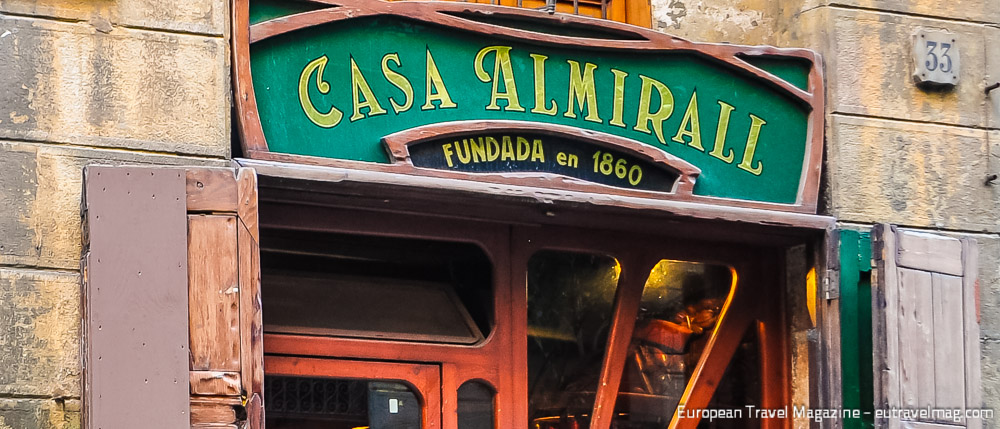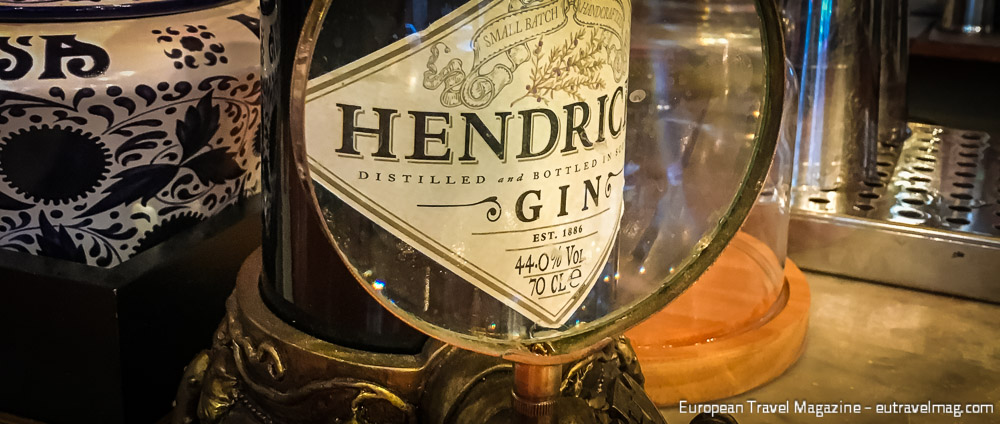That Barcelona offers world-class cuisine, is not a secret. That this trendy and vibrant city has an abundance of cool bars to choose from, comes as no surprise either.
But while you’re in a city that boasts so much astonishing Art Nouveau architecture – or Modernisme, as it’s called in this Catalan region – why not theme your Pub Crawl and crawl back in time as well! Back in a time and place, where Picasso held his first solo exhibition and Antoní Gaudí thought out his architectural Art Nouveau masterpieces (check out this article about the Top 10) over a jar of beer. Or something stronger.
We are back in a time where Absinthe was favoured by both the wealthy bourgeoisie, the poor artists and ordinary working-class people. A time, where the avantgarde movement shared their ideas in the growing number of bars, bistros and cafés. Let’s follow in their footsteps and discover the Art Nouveau Bars of Barcelona.
Els Quatre Gats
This café, established in 1897, was a Catalan pendant to the famous French cabaret “Chat Noir” and was a collaboration between the Catalan avant-garde at that time: Santiago Rusiñol and Ramon Casas together with the owner, Pere Romeu.
The building itself was designed by Puig i Cadafalch and if you’ve been to the Art Nouveau cava winery Cavas Codorniu, you might recognize his Gothic arched windows, that makes it look more like a medieval cellar from the inside. When you step into the pub, you’re transported back in time. Little has changed. From the large painting on the wall by Santiago Rusiñol of two gentlemen on a tandem to the menu, which front was designed by Picasso himself. The beer and wine here is not expensive either, so order a caña and cava and sit back and enjoy the ambiance.
This it the space where Picasso held his first solo exhibition in 1899. Antoni Gaudi was a frequent visitor here as well, and you can just imagine how the creative ideas have spawned of the intellectual discussions amidst these walls.
The establishment has a restaurant as well, which we didn’t visit but looked quite cozy. And the bar is open from 9 in the morning to 1 in the night.
El Paraigua
From the artist’s den we move further south into the Barri Gotic – the old, medieval neighborhood of Barcelona. Just behind Plaza Sant Jaume, you’ll find another Modernista masterpiece. This place is very popular for coffee in the early afternoon and becomes an alive venue later in the evening, when the downstairs cocktail bar opens at 22:30.
The café is decorated with original Art Nouveau elements but from a different location. The Galles store had sold umbrellas and fans from 1902 until 1967, when the building, in which it resided, was demolished. The entire interior decoration was dismantled and used in El Paraigua that opened in 1968.
It’s charming to sit and admire the original cash register from 1898 and the rest of the sinuous woodwork, floral motifs, beautiful bar and classic Art Nouveau lamps.
And don’t worry: you don’t have to wait until the evening to continue your Modernista intoxication mission. They have lots of spirits, wine and beers to choose from. And tapas and cake to go with whatever you choose! They open at 12:00 and close at different times at night, depending on the weekday.
Cafè de L’Opera
The next Art Nouveau watering hole down the Rambla is Cafè de L’Opera, which is quite more touristy, price-wise. While you can have a beer or wine here, it’s more a coffee-drinking kind of place. But even though the prices are exorbitant, you still shouldn’t miss it because of its bygone era mirrors on the wall, reflecting the customers of this century as they did the last.
They have a wonderful Art Nouveau bar and you are definitely taken back to fin-de-siecle when you sit here and contemplate life, death and everything in between over a cup of their signature hot chocolate. Or something stronger: they have an extensive whiskey collection!
The café, just opposite the Teatre del Liceu, opened in 1929 and has been run ever since by the same family. Even during the Spanish civil war the establishment remained open and continues to do so 365 days a year, 18 hours a day from 8 to 2.30.
Grill Room
While the title doesn’t have “Modernista gem” written all over it, this excellent restaurant with its sinuous woodwork will win you over, even as you approach. And when you’ve first eyed the glass mosaic, you just have to go inside to have peak. And a steak.
Inside, the display cabinets on the right continue with these organic lines and floral decoration and on the left, the bar and mirrors enhance the impact of this amazing artisanship. The cast iron pillars are another exceptional feature: You can still read the initials framed by a raging bull on the first column, recalling the business of the founder.
This establishment was one of two – probably identical – cafés that opened in 1902. The other one, located at Passeig de Gràcia, was named Café Torino and this one is believed to have been called Petit Torino. The present name was given back in 1916 when it was turned into a restaurant.
We can recommend you get some solid in here before you venture further on you bohemian pub crawl. The prices are reasonable: They have a varied selection and tasty grilled meat. You can even have a burger for less than 10€ if you’re wanting for something more than tapas.
If you’re wanting for something less and liquid however, this might not be the ideal place. Moreover, it’s only open for lunch and dinner. But you gotta eat, right?
Casa Almirall
Our sixth stop is in the neighbourhood on the other side of La Rambla; Raval. Here, you’ll find one of the oldest and best-preserved establishments in Barcelona. Casa Almirall has been around since 1860 and keeps serving cava and culture to this generation of Barcelonians.
The front end of the establishment has preserved its Modernista interior, especially the marble counter and display cabinet behind give great character to the bar and are perhaps the most recognisable Art Nouveau elements. The most outstanding effect of the decoration is created by the woodwork, with curved lines going sidewards where they meet other lines, interlacing to form a dense ornamentation of branches with leaves and flowers that emerge from the end of display cabinet and rise upwards. Amazing. And the cast iron woman holding the torch high is the muse of the Universal Exhibition of Barcelona held in 1888.
You should try their Oliveta, a traditional Vermouth (I know, it sound like something from our parents’ generation) or the Absinthe, if you’re daring for something stronger. Don’t worry, it’s not hallucinogenic or trippy liquor. It’s just a tad stronger than regular liquor.
The Raval area is still a bit dark and seedy but the bar is just next to several museums, so the clientele and surroundings are not that bad. Visit the bar in the early afternoon if you’re not comfortable with the neighbourhood. They open at 19:00 and close at 3:00.
La Confiteria
Our final suggestion for you is La Confiteria in the far corner of the Raval neighborhood, near the theatre-packed Avinguda Parallel. But it’s worth the hike! The name means The Confectioner and it certainly is eye-candy for any Art Nouveau lover. And the cocktails they create are pure candy for the taste buds.
This charming place was converted into a confectioner’s between 1912 and 1913 and the original decorations have all been retained and even enhanced. Before the last restoration the beautiful wooden display cabinet was covered with decades of paint layers, but the exposed woodwork has now been revealed.
The atmosphere of the bar varies according to the time of day: in the afternoon it is frequented by anyone who wants to have a snack or a chat among friends, but at night it’s filled with a varied clientele, who come to have a light snack after leaving one of the many theatres on the Avinguda Parallel or stay until the early hours.
The cocktails we savoured, were probably the best cocktails we had so far, during our 7 months in France, Portugal and Spain. And we visited some pretty good spots in Porto as well. The cocktail creativity and craftsmanship is highly addictive and if our wallets had been bigger, we would have stayed all night as well. Try to prove us wrong: they are open from 19:00 to 2:30 in the weekdays and 17:00 to 3:00 in the weekend.
Closed 2022: Cafe Viena Rambles
On the Rambla – the arterial vein of Barcelona – tourist traps just lie in waiting, until you find this surprising unpretentious café, that serves – according to New York Times – the best sandwich in town! A draught beer and small bottle of cava will set you back less than 6 Euros. And if you need a bite, the price is not bad as well.
We savoured a light lunch, a cold one and a cava at the horseshoe formed bar, a concept that right away lends a friendly feeling in the room, where you can look the bartender and every customer in the eye, and where smiles that are given, are shared with the rest of the café.
The Modernista café was established in 1889, which you can see from the bronze plate outside. The building however, was finished a little earlier, in 1883, and its most distinguishing feature is the clock on the façade, that is popularly acknowledged to set the official time of Barcelona. Another element of interest on the façade is its elegant bay window. The dome and domed tower that crown the building originally housed a meteorological and astronomical observator.
The woodwork’s organic forms are clear Art Nouveau style as are its decorations, and when you leave, maybe you feel like we do: grateful, that there are still historic establishments like these around in the tourist hubbub, that after all gives a good value for the price paid. They are open every day from 8 to 1.
General information
- Visit Barcelona website
- Modernisme on Wikipedia
- History of the Modernista bars in detail on Ruta del Modernisme website
































































Fantastic article. I knew some of these bars but I keep this article to visit the bars I didn’t know. When I travel I enjoy visiting traditional bars ou tea rooms. They have always a special atmosphere.
Thanks Claude! Good to know, we could inspire a seasoned Barcelona Traveller 🙂
I agree, there’s so much soul in the old establishments!
“Modernisme” is Catalan, not Spanish. The word itself is in Catalan, and the movement is from Catalonia also.
Hi Francisco – Thanks for the correction! I have rectified the text.